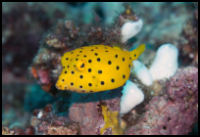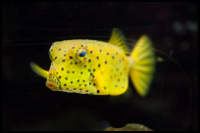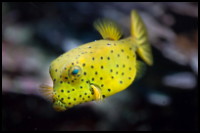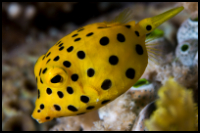





Quick Care Details (Table)
| Livestock Characteristics | Value |
|---|---|
| Care Level | Expert |
| Temperament | Peaceful |
| Diet | Omnivore |
| Maximum Size | 18 Inches |
| Minimum Tank Size | 125 Gallons |
| Plant Safe | Yes |
| Temperature Range | 75-82°F |
| PH Range | 7.8-8.4 |
| Alkalinity Range | 8-12 dKH |
| Salinity | 1.022-1.025 |
Species Specific Categories
Helpful Video
Care Details
Aquascape
- Provide ample swimming space and open areas to accommodate the Cubicus Boxfish's need for movement.
- Incorporate live rock structures and coral decorations to mimic its natural reef habitat.
- Avoid sharp edges or tight spaces that might cause injury to its delicate body.
Substrate
- Choose a fine sand substrate to create a natural environment and prevent any abrasions to the Boxfish's underbelly.
Disease Prevention
- Quarantine new additions before introducing them to the main tank to prevent potential diseases.
- Maintain excellent water quality and perform regular water changes to reduce stress and prevent disease outbreaks.
Filtration
- Utilize a high-quality protein skimmer and efficient mechanical and biological filtration to maintain water clarity and quality.
- Regularly clean and maintain filtration equipment to prevent buildup and ensure optimal performance.
Lighting
- Moderate lighting is sufficient for the Cubicus Boxfish, as it prefers dimmer areas within the aquarium.
- Avoid intense lighting to prevent stress and potential bleaching of the fish's delicate skin.
Water Flow
- Provide gentle water flow to ensure adequate oxygenation without creating strong currents that might stress the Boxfish.
Hardiness
- The Cubicus Boxfish is considered relatively hardy when kept in suitable conditions.
- Stable water parameters, proper acclimation, and a well-maintained environment contribute to its well-being.
Acclimation
- Slow and gradual acclimation is crucial when introducing a Cubicus Boxfish to a new tank to minimize stress and shock.
- Drip acclimation over a period of time helps the fish adjust to the new water conditions.
Special Requirements
- The Cubicus Boxfish has delicate skin that is prone to scrapes and injuries, so be cautious when handling and during tank maintenance.
- Avoid housing with aggressive tank mates that might harass or stress the Boxfish.
- Be prepared to deal with the potential release of toxins if the Boxfish feels threatened or stressed. Provide ample hiding places to reduce stress.
Temperament and Behavior
Behavior and Social Interaction
- The Cubicus Boxfish is generally peaceful and well-mannered, making it a suitable addition to community aquariums.
- It has a calm demeanor and spends its time leisurely exploring its surroundings.
Aggression
- The Cubicus Boxfish is not known for being aggressive towards other fish or invertebrates.
- However, it's important to avoid keeping it with aggressive tank mates that might harass or stress it.
Breeding
- Breeding the Cubicus Boxfish in captivity is extremely rare and challenging due to their complex reproductive behaviors and specific requirements.
Compatibility
- The Cubicus Boxfish is compatible with a variety of peaceful tank mates that won't threaten or stress it.
- Avoid housing it with aggressive or territorial fish that could potentially harm the Boxfish.
Activity Level
- The Cubicus Boxfish has a moderate activity level. It spends its time leisurely swimming around and exploring its environment.
Clean-up Crew
- While not a traditional member of the "clean-up crew," the Cubicus Boxfish can play a role in controlling small pest invertebrate populations.
- Be cautious when keeping it with other fish that are part of the clean-up crew, as the Boxfish might compete for the same food sources.
Schooling or Shoaling Behavior
- The Cubicus Boxfish does not exhibit schooling or shoaling behavior. It tends to be solitary or pairs up when it finds a mate.
Diet and Nutrition
Dry Foods
- Cubicus Boxfish can be trained to accept high-quality marine pellets and flakes as part of their diet.
- Look for pellets specifically formulated for herbivorous or omnivorous marine fish.
Frozen Foods
- Offer frozen foods like mysis shrimp, brine shrimp, and krill as occasional treats.
- Frozen foods provide variety and help mimic the natural diet of the Cubicus Boxfish.
Live Foods
- Live foods like brine shrimp, copepods, and small worms can be offered to enhance the Cubicus Boxfish's diet.
- Ensure that live foods are from reliable sources to prevent introducing parasites or diseases to the tank.
Vegetables
- Cubicus Boxfish are herbivorous and benefit from occasional offerings of blanched vegetables like spinach, lettuce, and seaweed.
- Attach the vegetables to a feeding clip to prevent them from floating away before the Boxfish can consume them.
Algae
- Providing a source of marine algae or seaweed sheets can be beneficial for the Cubicus Boxfish's diet.
- Algae mimic their natural diet and help provide essential nutrients.
Feeding Schedule
- Feed the Cubicus Boxfish small amounts multiple times a day rather than one large meal.
- Aim for consistency in feeding times to establish a routine for the fish.
Supplemental Foods
- Consider offering high-quality vitamin and mineral supplements to ensure a well-rounded diet.
- Consult with experienced aquarists or marine veterinarians for specific supplement recommendations.
Tank Parameters
Tank Size
- A tank with a minimum capacity of 125 gallons is recommended for a single Cubicus Boxfish.
- Larger tanks offer more stable water conditions and provide enough swimming space for the fish.
Tank Length and Measurements
- Aim for a tank that is at least 6 feet in length to accommodate the Cubicus Boxfish's swimming habits.
Species Maximum Size
- The Cubicus Boxfish can reach a maximum size of around 18 inches.
Water Temperature
- Maintain a water temperature within the range of 74 to 78°F (23 to 26°C).
- Avoid rapid fluctuations in temperature to prevent stress on the fish.
pH (Acidity/Alkalinity)
- Maintain a pH level between 8.1 and 8.4 to create a suitable alkaline environment.
Nitrate (NO3) Levels
- Keep nitrate levels below 20 ppm to ensure good water quality and minimize stress on the fish.
Salinity
- Maintain a salinity level between 1.020 and 1.025 specific gravity (30 to 35 ppt) for a marine environment.
Phosphate (PO4)
- Aim to keep phosphate levels low, ideally below 0.1 ppm, to prevent algae growth and maintain water quality.
Alkalinity (dKH)
- Aim for an alkalinity level between 7 and 10 dKH to help maintain pH stability.
History, Popularity, History and Species Variety Details
The History, Popularity and Habitat of The Cubicus Boxfish
History: The Cubicus Boxfish, scientifically known as Ostracion cubicus, is a captivating marine species that has intrigued marine enthusiasts and aquarists alike. This unique fish belongs to the family Ostraciidae, commonly referred to as boxfishes or cowfishes. The Ostraciidae family includes several species with distinctive box-like bodies, and the Cubicus Boxfish is a standout representative.
Popularity: The Cubicus Boxfish has garnered attention in the aquarium hobby due to its striking appearance and endearing behaviors. Its geometrically patterned body, reminiscent of a three-dimensional puzzle, adds a touch of intrigue to marine tanks. While not as commonly kept as some other marine species, the Cubicus Boxfish's popularity has been steadily growing among experienced aquarists who appreciate its unique charm.
Habitat: In the wild, the Cubicus Boxfish is found in tropical and subtropical waters of the Indo-Pacific region, including the Indian Ocean and the western Pacific Ocean. It inhabits shallow coral reefs, lagoons, and seagrass beds. Its natural habitat is often characterized by vibrant coral formations, sandy substrate, and clear, warm waters. The Cubicus Boxfish's preference for reef environments makes it an integral part of the intricate marine ecosystems.
This species is known to be a slow swimmer, often seen leisurely exploring its surroundings or hovering above the reef. Its distinctive body shape, resembling a cube with striking patterns, provides excellent camouflage among coral formations and adds to its allure.
The Cubicus Boxfish's role in the wild ecosystem includes feeding on small invertebrates, algae, and other marine organisms. Its presence helps maintain the balance of populations within the coral reef community.
While it adapts well to captive environments, providing a suitable tank setup that mimics its natural habitat is crucial for the well-being of the Cubicus Boxfish. Reef-style tanks with live rock structures, appropriate hiding places, and a variety of substrates help recreate its native environment and offer an enriching experience for both the fish and the aquarist.
Back to top
Different Types of Boxfish
Longhorn Cowfish (Lactoria cornuta):
- Recognizable by its long, prominent "horns" on its head.
- Known for its unique swimming style and quirky behaviors.
- Can change color and pattern to some extent.
Whitespotted Boxfish (Ostracion meleagris):
- Features white spots and patterns on a dark body, resembling a constellation.
- Found in the Indo-Pacific region.
- Like other boxfish, it has a square-shaped body.
Black Boxfish (Ostracion cubicus):
- Also known as the Black Cubicus Boxfish.
- A color variation of the Cubicus Boxfish with a predominantly black body and white markings.
- Shares the unique box-like appearance of the family.
Scribbled Boxfish (Acanthostracion polygonius):
- Notable for its intricate scribble-like patterns covering its body.
- Inhabits the Caribbean Sea and the western Atlantic Ocean.
- Exhibits similar box-like shape as other boxfish.
Honeycomb Cowfish (Acanthostracion polygonius):
- Features a distinctive hexagonal pattern on its body.
- Found in the tropical waters of the Atlantic Ocean.
- Possesses a boxy body with small fins.
Yellow Boxfish (Ostracion cubicus):
- Also known as the Yellow Cubicus Boxfish.
- Exhibits a yellow coloration with black markings, similar to its cousin, the Cubicus Boxfish.
- Popular in the aquarium trade for its vibrant appearance.
Papuan Toby (Canthigaster papua):
- Belongs to the same family but is smaller in size and has a more spherical body.
- Known for its toxic skin, which contains tetrodotoxin for defense against predators.
- Found in the Indo-Pacific region.
Scrawled Cowfish (Acanthostracion quadricornis):
- Named for its intricate scrawled patterns.
- Inhabits coral reefs in the western Atlantic Ocean.
- Has a distinctive rectangular body shape.
Back to top
Commonly Compatible Tank Mates
Tangs:
These fish belong to the family Acanthuridae and are often recognized for their small mouths, which they use to graze on algae and other plant matter in the wild. Tangs come in a variety of sizes, colors, and patterns, making them popular choices for reef and marine aquariums. Their graceful swimming and foraging behaviors add life and energy to underwater environments.
Anthias:
Anthias are stunning marine fish that come in a dazzling array of colors and patterns. They bring life and movement to aquariums with their vibrant hues and graceful swimming. Anthias are often found in social groups, creating captivating displays of synchronized motion. These fish are generally peaceful but can be a bit delicate, requiring stable water conditions and a varied diet. With their beauty and dynamic presence, anthias are sought-after additions to reef and marine tanks.
Rabbitfish:
Rabbitfish, also known as foxface fish, are charming marine species known for their rabbit-like snouts and striking coloration. They often sport intricate patterns and vibrant hues that enhance the visual appeal of aquariums. Rabbitfish are herbivorous, primarily feeding on algae and plant matter. They are generally peaceful but can be territorial, especially towards their own kind.
Clownfish:
These small fish have a special symbiotic relationship with sea anemones, seeking refuge in their stinging tentacles and providing them with food in return. With their endearing antics and striking patterns, clownfish have captured the hearts of both aquarists and movie enthusiasts alike. Their adaptability, hardiness, and ability to thrive in home aquariums make them a popular and delightful choice for marine enthusiasts of all levels.
Hawkfish:
Hawkfish are captivating marine fish known for their distinct personalities and unique perching behavior. With their bold colors and eye-catching patterns, they add a splash of vibrancy to aquariums. Hawkfish often perch on rocks or corals, keeping a watchful eye on their surroundings and showing off their inquisitive nature. While they're generally peaceful, some species may display territorial behavior. Their combination of striking appearance and engaging behaviors makes hawkfish a popular choice for marine hobbyists looking to add character and charm to their underwater ecosystems.
Chromis:
Chromis are delightful marine fish that come in a variety of vibrant colors, instantly brightening up aquariums. These small, schooling fish exhibit a graceful and synchronized swimming behavior, creating captivating displays of movement. Chromis are known for their peaceful nature, making them suitable for community tanks. With their hardy disposition and visually appealing presence, chromis are popular choices for both beginners and experienced marine enthusiasts, contributing to the lively and colorful ambiance of underwater environments.
Back to topFrequently Asked Questions
Is the Cubicus Boxfish reef-safe?
Yes, the Cubicus Boxfish is generally reef-safe and won't harm corals or other invertebrates.
How should I acclimate a Cubicus Boxfish to my tank?
Acclimate slowly using the drip method over several hours to help the fish adjust to the new water conditions.
What's the lifespan of a Cubicus Boxfish in captivity?
With proper care, a Cubicus Boxfish can live up to 5 to 10 years or more in captivity.
Can the Cubicus Boxfish produce toxins?
Yes, the Cubicus Boxfish has the ability to produce toxins as a defense mechanism. However, the potency of these toxins in captivity is relatively low.
Can the Cubicus Boxfish be kept with aggressive fish?
It's not recommended to keep the Cubicus Boxfish with aggressive tank mates, as its slow movement and calm nature might make it an easy target.

